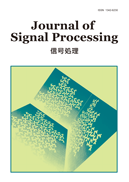
- Issue 6 Pages 203-
- Issue 5 Pages 155-
- Issue 4 Pages 123-
- Issue 3 Pages 93-
- Issue 2 Pages 53-
- Issue 1 Pages 1-
- |<
- <
- 1
- >
- >|
-
Kosuke Katayama, Takaaki Baba, Takashi Ohsawa2021Volume 25Issue 3 Pages 93-101
Published: May 01, 2021
Released on J-STAGE: May 01, 2021
JOURNAL FREE ACCESSIn this paper, we evaluate the system of wireless distributed computing (WDC) including a 1×2 array Yagi-antenna de-signed for the system. This antenna is developed on a glass-epoxy printed circuit board and its geometry is as compact as 1.6×150×200 mm3. The double rat-race balun, which also works as a power divider of the array, greatly reduces insertion losses from the RF port to driver elements of the antenna and greatly increases the operational bandwidth. As a result, the insertion loss is about 2 dB and the antenna operates from 2.1 to 2.5 GHz. Since the double rat-race balun also has good isolation between the ports of the arrayed driver elements, this array antenna seems to be driven with independent RF signals and achieves the high gain of 13.0 dBi. The radiation pattern of this antenna is suitable for WDC. Since the half-power beamwidth of the azimuth angle is wider than that of the elevation angle, a greater number of computational nodes on the ground surface are covered. We confirm that WDC has an enhanced computa-tional speed when using this antenna. WDC with twelve threads achieves 550% acceleration in comparison with the case of one thread.
View full abstractDownload PDF (719K) -
Yuki Kuno, Yasuyuki Okumura, Katsuyuki Fujii2021Volume 25Issue 3 Pages 103-109
Published: May 01, 2021
Released on J-STAGE: May 01, 2021
JOURNAL FREE ACCESSDuring the transition from current passive optical networks to next-generation systems, the error rate is expected to increase owing to the coexistence of on-off keying (OOK) which is used in the current optical network and phase-shift keying (PSK) for the next-generation system. Moreover, the currently used bias transmission method is problematic owing to excessive transmission power. Therefore, in this study, a trellis coded modulation, which is an error correction method, is proposed and evaluated, and a clip transmission method, which is a power reduction method, is applied to an environment where OOK and 8-PSK coexist. The effectiveness of the proposed approach was confirmed through a reduction in the received power of approximately 2.9 and 4.5 dB in PSK and OOK, respectively.
View full abstractDownload PDF (461K) -
24. Application of Multiwire Transmission-Line Theory to the Analysis of Acoustic Characteristics of Vocal TractsKunitoshi Motoki, Nobuo Nagai2021Volume 25Issue 3 Pages 111-116
Published: May 01, 2021
Released on J-STAGE: May 01, 2021
JOURNAL FREE ACCESSThe acoustic characteristics of a simplified three-dimensional vocal-tract model can be calculated using the multiwire transmission line theory. The acoustic field is represented in terms of both plane waves and higher-order modes in the vocal-tract model. This model is constructed using an asymmetrically connected structure of rectangular acoustic tubes to approximate a real vocal tract and can parametrically represent acoustic characteristics at higher frequencies where the assumption of plane wave propagation does not hold. Equivalent electrical transmission lines are introduced both for the propagative modes and evanescent modes in order to represent the localized distribution of sound pressure. The computational results show that additional peaks and valleys in the vocal-tract transfer functions can appear even for the case without any branch in the vocal tract. It is also shown that the visualization of the acoustic field is useful for understanding the phenomena of wave propagation in the vocal tract.
View full abstractDownload PDF (397K) -
2021Volume 25Issue 3 Pages 117-119
Published: May 01, 2021
Released on J-STAGE: May 01, 2021
JOURNAL FREE ACCESSDownload PDF (275K) -
2021Volume 25Issue 3 Pages 121-122
Published: May 01, 2021
Released on J-STAGE: May 01, 2021
JOURNAL FREE ACCESSDownload PDF (92K)
- |<
- <
- 1
- >
- >|